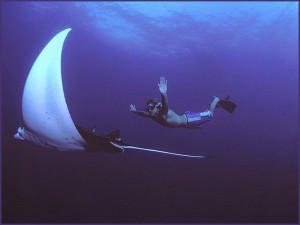Mantas are inquisitive and, if unthreatened, may approach divers for a closer look. However, in some areas where manta encounters have not been responsibly managed, mantas have become very wary and refuse to approach.
When approached rapidly or grasped, they may roll on to their backs, dive, or swim away rapidly. They will only right themselves when some distance away, and are likely to remain wary after being disturbed.

A manta swims directly beneath a patient snorkeler. Photo courtesy Fiona Ayerst
Divers who take steps to enter the water and approach mantas carefully will greatly increase the enjoyment of their encounter, and protect the mantas from injury. By hovering and staying still near to the reef or seafloor, divers can encourage mantas to approach. By allowing the manta to control the encounter, divers are likely to have a much more spectacular manta experience.
Touching a manta should never be attempted, even if it seems to be presenting itself for a rub. A simple touch can remove the mucus layer covering the skin that protects against parasites and infections. This can lead to lesions and injury. Remember to never ride a manta ray!
At all times, divers should stay within the manta’s field of vision, and let it decide whether to approach. Be aware of your exhaled bubbles, as these can startle a curious manta.
Excessive flash photography and video may disturb mantas, particularly if they are engaged in feeding, cleaning or mating.
Direct eye contact is considered a friendly connection, which they seem to enjoy.
For more information on interacting with mantas, see our code of conduct.
